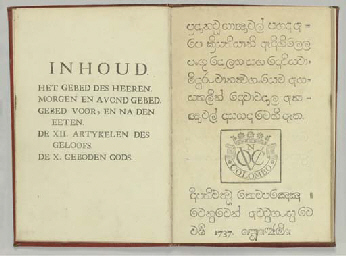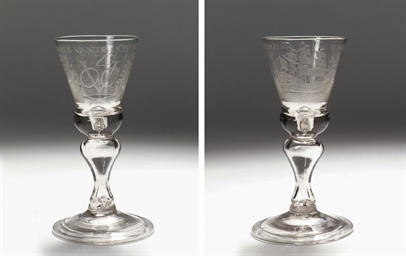A Dutch East India Company bronze mortar cannon, 18th century, the domed cascabel cast with trunnions, the breech with scallop shell vent guard and struck JANVER.. at the first reinforce, the large-bore bell-shaped barrel with lifting loop at the second reinforce and astragal moulded muzzle revealing 15 inch bore, 90cm long, maximum diameter 53cm. : The property of a private collector. Recovered from the wreck of an early 19th century Dutch East Indiaman off the west coast of Africa which was lost on a return trip from Batavia with a cargo including redundant cannon for smelting. Purchased directly from the salvers circa 1980. cannon were designed to lob hollow explosive-filled projectiles over obstacles such as the wall of a fortress. The maritime application mortar cannon was first capitalised by the French in the late 17th century who developed 'bomb vessels' so that mortars can be fired from an offshore location. The earliest bomb vessels were usually adapted from other small craft suitably strengthened and often with the foremast removed to make room for the mortar to be placed amidships. During the 18th century the British developed a specific vessel for this role the 'bomb ketch'. Such vessels were almost exclusively used to attack land based targets often deployed to disable enemy coastal forts or to assist in amphibious operations. Offshore mortars were employed to bomb the city during the battle of Copenhagen in 1801, with the bomb vessels placed the seaward side of the attacking British fleet. mortars tended to be designed with slightly longer barrels than their land-base counterparts mainly in an attempt to improve accuracy but also to reduce the chance of setting fire to the bomb vessel by containing the spread of the blast from the muzzle. The current lot is similar to the French 1732 pattern mortar and was probably primarily designed to be used on land. Condition report disclaimer
A Dutch East India Company bronze mortar cannon, 18th century, the domed cascabel cast with trunnions, the breech with scallop shell vent guard and struck JANVER.. at the first reinforce, the large-bore bell-shaped barrel with lifting loop at the second reinforce and astragal moulded muzzle revealing 15 inch bore, 90cm long, maximum diameter 53cm. : The property of a private collector. Recovered from the wreck of an early 19th century Dutch East Indiaman off the west coast of Africa which was lost on a return trip from Batavia with a cargo including redundant cannon for smelting. Purchased directly from the salvers circa 1980. cannon were designed to lob hollow explosive-filled projectiles over obstacles such as the wall of a fortress. The maritime application mortar cannon was first capitalised by the French in the late 17th century who developed 'bomb vessels' so that mortars can be fired from an offshore location. The earliest bomb vessels were usually adapted from other small craft suitably strengthened and often with the foremast removed to make room for the mortar to be placed amidships. During the 18th century the British developed a specific vessel for this role the 'bomb ketch'. Such vessels were almost exclusively used to attack land based targets often deployed to disable enemy coastal forts or to assist in amphibious operations. Offshore mortars were employed to bomb the city during the battle of Copenhagen in 1801, with the bomb vessels placed the seaward side of the attacking British fleet. mortars tended to be designed with slightly longer barrels than their land-base counterparts mainly in an attempt to improve accuracy but also to reduce the chance of setting fire to the bomb vessel by containing the spread of the blast from the muzzle. The current lot is similar to the French 1732 pattern mortar and was probably primarily designed to be used on land. Condition report disclaimer















Testen Sie LotSearch und seine Premium-Features 7 Tage - ohne Kosten!
Lassen Sie sich automatisch über neue Objekte in kommenden Auktionen benachrichtigen.
Suchauftrag anlegen